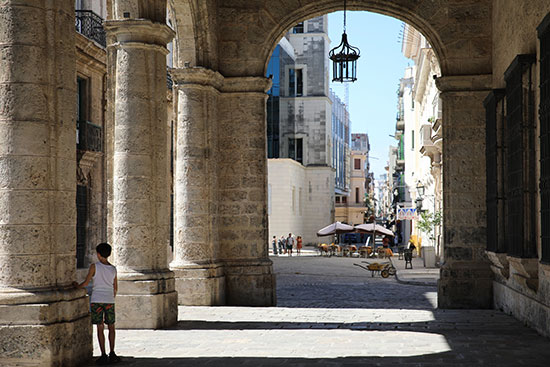
A window to Havana. Near Plaza De Armas,
a scenic tree-lined plaza surrounded by many of the
most historic structures and important monuments
in Cuba, a boy leans on a limestone pillar. Photo:
Joe Forward
Dani Perez will never forget Dec. 17, 2014. It was the day U.S. President Barack Obama announced a shift in U.S. policy toward Cuba – a normalization of relations between two countries estranged in a complicated history spanning more than 50 years.
“It was probably one of the happiest days of my life,” said Perez, a lawyer who develops and leads trips to Cuba through Cuba Cultural Travel, a California-based travel company authorized to operate educational tours to Cuba. “The excitement on both sides was remarkable.”
Perez led a five-day educational tour to Cuba with more than 40 Wisconsin lawyers in February, through a partnership between State Bar of Wisconsin PINNACLE® and Cuba Cultural Travel. The purpose of the trip was to educate lawyers about Cuban culture, the Cuban legal system, and U.S.-Cuba relations and to provide a glimpse of Cuban life.
Perez’s interest and intrigue with Cuba are personal. His grandfather emigrated to the United States from Cuba in 1955, before the Cuban Revolution. Perez has relatives there, more than 20 cousins. He first visited Cuba in 2003, as a 19-year-old college student, and the experience stuck with him.
“It was very powerful,” said Perez, who is fluent in Spanish and now lives in California. “I began to understand more about my Cuban roots. I fell in love with the people and the culture.”
Perez attended law school in Washington, D.C., specifically to learn about Cuba, and worked with U.S. lawmakers on foreign policy issues related to Cuba and the embargo. Now, Perez is an informal ambassador. He has traveled to Cuba about 10 times per year for the last four years.
 Joe Forward, Saint Louis Univ. School of Law 2010, is a legal writer for the State Bar of Wisconsin, Madison. He can be reached by email or by phone at (608) 250-6161.
Joe Forward, Saint Louis Univ. School of Law 2010, is a legal writer for the State Bar of Wisconsin, Madison. He can be reached by email or by phone at (608) 250-6161.
The Wisconsin group, including me, explored Cuban music, food, art, and culture and heard daily presentations about Cuban law, the legal system, and U.S.-Cuba relations from local professors and lawyers. The experience provided a first-hand perspective on Cuba.
“A big part of my interest in visiting was the sense of mystery that surrounds Cuba,” said Monroe attorney Dan Bestul, who took the trip with his wife, Sandy, and his two law partners.
“What little information we get is filtered through one perspective or another. I was excited to have the chance to see and experience things for myself.”
Linda Crane, a law professor at John Marshall Law School in Chicago who studies Cuba and has traveled there numerous times, may have summarized it best when she wrote: “[T]here is a lot of room for reasonable people to disagree because there is nothing simple about Cuba.”1
Some encourage a restoration of relations between the United States and Cuba, whose people have long suffered in economic poverty. Others remain steadfast in their conviction that U.S. policy should continue its embargo policies against Cuba, citing a repressive socialist government.
In this article, I take no position on that foreign policy issue but merely provide some perspectives from lawyers who visited Cuba, myself included. At the same time, I try to provide a brief history of U.S.-Cuba relations, including what is happening in real time, today.
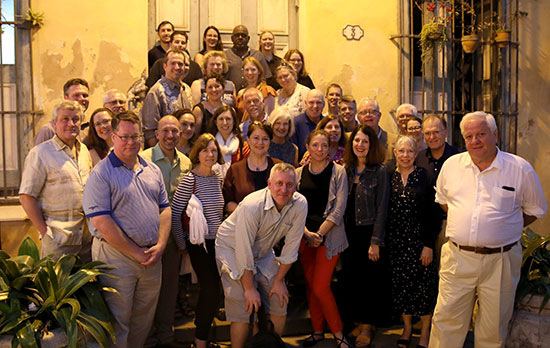
More than 40 Wisconsin lawyers traveled to Cuba in February as part of a program sponsored by State Bar of Wisconsin PINNACLE® in collaboration with Cuba Cultural Travel. The group heard presentations from Cuban lawyers and professors about the Cuban legal system, legal reforms, and U.S.-Cuban relations while exploring the Cuban culture in Havana and beyond.
A Complicated History
Those familiar with U.S.-Cuba history recall that U.S.-Cuba relations disintegrated after the Cuban Revolution in 1959, when 32-year-old lawyer Fidel Castro and his revolutionaries ousted dictator and Cuban president Fulgencio Batista. Batista was friendly to U.S. business interests, including the influence of Mafiosos investing in Havana’s emerging casino industry.
Batista and many of his associates fled Cuba in 1959 as Castro and his rebels, including brother Raul Castro and guerrilla leader Che Guevara, seized power in Havana and began the process of installing a one-party socialist republic, eventually controlled by the Cuban Communist Party.
The Cuban Revolution’s vision for a communist Cuba is at odds with American democracy. Cubans and tourists are keenly aware of the police and state security forces often used to prohibit dissident protests or chill political speech. The same civil liberties Americans enjoy can be denied in Cuba, and dissidents can be arrested and detained for political activism or speech against the government. The country’s newspaper, Granma, is run by the state.
Many of the American cars exported to Cuba in the 1950s still buzz the streets of Havana, using makeshift parts made in Russia or China. The Aqua Net hairspray of the American 1980s is still popular in Cuba now.
“There are signs and murals that are visible reminders of the Revolution, but I did not get the sense of coercion I felt in Spain during the end of Franco’s tenure,” Bestul said. “I expected to see far more signs of government authority than I did.”
“When I got off the plane, I was still under the impression that we would be very restricted in where we could go and what we could do,” Bestul said. “I quickly learned that wasn’t the case.”
Under Prime Minister Fidel Castro and President Osvaldo Dorticos Torrado, also a lawyer and former head of the Cuban Bar Association,2 one of the revolution’s first actions was to nationalize U.S.-owned assets and property. Between 1959 and 1961, the Cuban government seized banks, money, agricultural and mining lands, utilities, oil refineries, sugar plantations, hotels, ships, and private residences. There was talk of some compensation, but negotiations failed.3
“As American corporate and private entities controlled two-thirds of the [Cuban] economy, this was the largest uncompensated taking of American property by a foreign government in history,” wrote lawyer Timothy Ashby,4 a former director within the U.S. Commerce Department who now advises companies on commercial transactions in Cuba. “These nationalizations were the primary cause of the U.S. embargo that has remained in place for nearly half a century.”
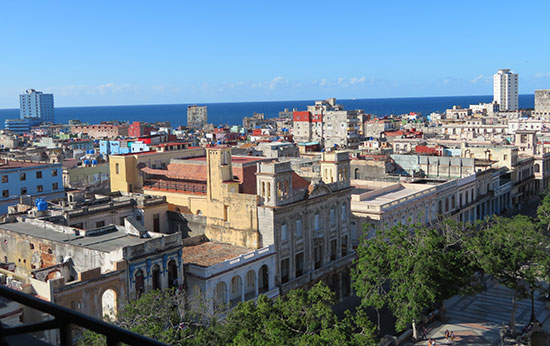
Havana by the sea. An eclectic mix of architecture tells a story about Havana, as well as its struggles. Here, a view from the Hotel Parque Central, including the tree-lined boardwalk below, Paseo del Prado, where the Cuban people relax and converse. Photo: Tiffany Highstrom
U.S. Cuts Ties, Imposes Embargo
After nationalization, the United States began enacting economic sanctions against Cuba, and it cut diplomatic ties. In 1962, President John F. Kennedy announced a total embargo, under the Foreign Assistance Act, banning all imports that were “of Cuban origin or passed through Cuba.”5 Kennedy reportedly secured 1,200 Cuban cigars before the embargo took effect.6
The embargo, or “bloqueo” as it is referred to in Cuba, prevents all U.S. trade to and from Cuba and prohibits other countries that use materials of Cuban origin from importing their products into the United States. For instance, a Canadian or Mexican company that uses Cuban sugar in a food or beverage product cannot import that food or beverage into the United States.
In addition, the embargo prohibits the transport of U.S. goods on ships owned by companies that transact business with Cuba and prohibits foreign aid to countries that provide foreign aid to Cuba.7 Kennedy also banned travel to Cuba, in 1963, through legislative authority. Travel restrictions have changed many times over the course of many administrations.8
Visiting Americans seem to embrace Cuba’s vibrant culture, the arts, the music, and of course, the rum and cigars, which are second to none.
Because of the embargo, Cuba resembles a time capsule. Many of the American cars exported to Cuba in the 1950s still buzz the streets of Havana, using makeshift parts made in Russia or China. The Aqua Net hairspray of the American 1980s is still popular in Cuba now. The Cuban people love their American cars and baseball, and they welcome Americans to Cuba.
“This was an opportunity to learn about a culture and society that I did not know much about,” said Milwaukee lawyer Daniel Pedriana, an avid fisherman. “I met a friendly Cuban man by the sea wall and spent almost an hour chatting with him as we compared our respective lives.
“It was fascinating and something I won’t soon forget,” said Pedriana, who also visited Finca Vigia, Ernest Hemingway’s former home outside Havana. Hemingway wrote The Old Man and the Sea at Finca Vigia in 1951 and kept his boat, Pilar, at nearby Cojimar, a fishing village.
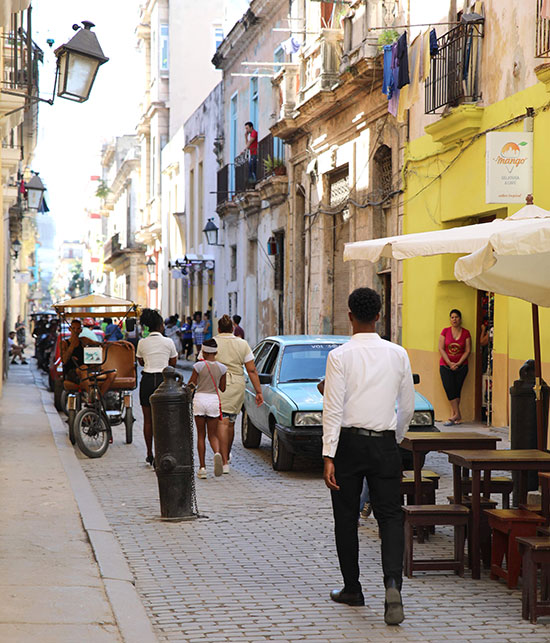
Calle San Ignacio (San Ignacio Street). Along the picturesque Plaza Vieja (Old Square), Cuban people and tourists walk the narrow cobblestone side streets. A walking tour allowed the group to see many historic sites in Havana. Photo: Joe Forward
Perez said Cubans understand that the U.S. and Cuban governments, not their people, are at odds, and the Cuban people embrace all things America.
“They love our American movies, music, culture, clothes – they still look up to us in those ways and now that you have rising consumerism, they want American everything,” Perez said.
Visiting Americans seem to embrace Cuba’s vibrant culture, the arts, the music, and of course, the rum and cigars, which are second to none. The Cuban architecture is also an eye-popping collage of history that the State Bar of Wisconsin contingent learned about on various walking tours.
Americans will undoubtedly continue to visit Cuba, despite differences between the U.S. and Cuba governments, to learn more about the Cuban people and the country’s culture.
A mix of colorful Spanish colonial-style buildings line many of Havana’s cobblestone streets, leading to dramatic and sun-soaked plazas – such as Plaza de Armas, Plaza de la Catedral, and Plaza Vieja – where Cubans and tourists alike take in music and afternoon mojitos.
American, French, Italian, and Soviet architectural influences, including Baroque-style cathedrals, mark time periods in Cuban history, as does the poverty Cuba has experienced over time. Many of the buildings and structures are in disrepair.
“It really is a country of complex contrasts; there are reminders of the country’s history at every turn, because it has never been replaced,” said Madison lawyer Tiffany Highstrom, who took the trip to Cuba with a cohort of lawyer-friends from Beaver Dam.
The Special Period
The embargo followed the U.S.-backed invasion known as the Bay of Pigs, an attempt to overthrow Castro’s regime using CIA-trained Cuban exiles. The invasion failed, and Cuba’s socialist regime has remained in power despite U.S. policies exerting pressure to reform.
After the embargo, Cuba’s leadership secured financial support from the Soviet Union, a communist ally and U.S. enemy. The Cold War nearly erupted in 1962, when the Soviets placed nuclear-armed missiles on Cuba, which is just 90 miles from the Florida coast.
“Even though the Cuban Missile Crisis eventually reached a peaceful resolution, it would impact relations between the United States and Cuba for decades,” according to authors of a recent article on the embargo and U.S. legislative and executive action toward Cuba.9
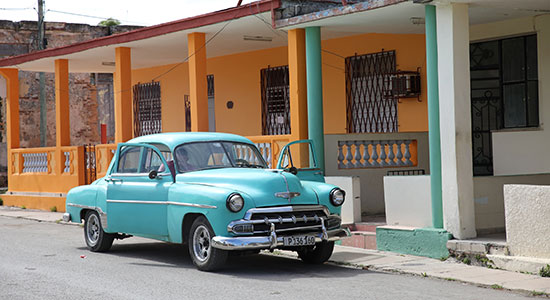
Vintage American. Because of the U.S. embargo on Cuba, American car exports to Cuba stopped in the early 1960s. Thus, many of the old American cars still buzz the streets in Cuba. Here, an old Chevy off the street in Cojimar, a fishing village where American expatriate and author Ernest Hemingway kept his boat, Pilar. Photo: Joe Forward
The Soviet Union’s financial support of Cuba, heavily reliant on Cuban sugar exports in exchange for oil, ended when the Soviet Union collapsed in 1989. The “special period” that followed in Cuba “was a time of major suffering and shortages for the Cuban people.”10
The State Bar contingent heard stories about this special period and how the Cuban people lived through it, through music and a sense of cultural belonging. “It was interesting to hear how the nation responded; their ability to handle adversity is amazing,” Bestul said.
“I got the sense that modern Cubans draw great strength from what they have dealt with over the years, and that includes the challenges posed by their neighbor to the north. We also got to see some of the resilience of the Cuban people in the post-Soviet era that some of the lecturers talked about – like farmers plowing fields with oxen because fuel for tractors, and tractors themselves, are hard to come by,” Bestul said.
Embargo Policies Continue
The revolution and the Cuban Missile Crisis are just two of the major historical events that shaped U.S. embargo policy toward Cuba. America’s unwavering stance against communism and socialism over the decades meant Cuba’s isolation would continue under Fidel Castro, who became Cuba’s president in 1976 and remained president until resigning for health reasons in 2008.
The Cuba Democracy Act, passed under President George H.W. Bush in 1992, banned foreign subsidiaries of U.S. companies from trading with Cuba, restricted family remittances to Cuba from the United States, and opposed any normalization efforts so long as the Castro regime “continues to refuse to move toward democratization and greater respect for human rights.”11
It is apparent that the Cuban people take pride in their culture, despite adversity, poverty, and other challenges.
President Bill Clinton signed the Cuban Liberty and Democratic Solidarity Act of 1996, known as the Helms-Burton Act, which codified the executive sanctions against Cuba and prohibits Congress from lifting the embargo unless Cuba has a democratically elected government.12
That law also requires Cuba to demonstrate progress in returning property taken by the Cuban government under nationalization or to provide full compensation – now about $8 billion with interest – under international law standards before the embargo can be lifted.13 Under Clinton, the United States also codified travel restrictions to Cuba. U.S. citizens traveling to Cuba require a special license related to specific activities, such as journalistic, religious, or educational activities, and the Cuba travel itinerary must adhere to certain requirements.14
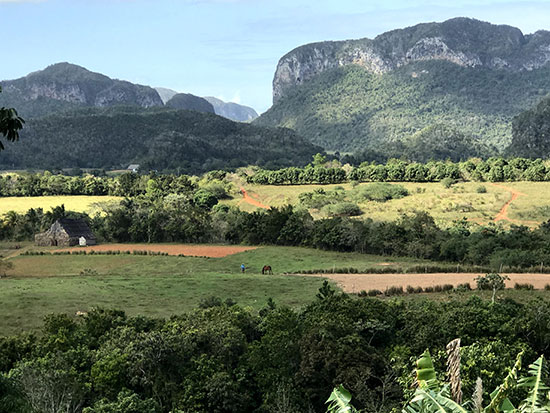
The Cuban countryside. About 100 miles east of Havana, the Vinales Valley is considered by many as the most beautiful place in Cuba. With stunning landscapes, it is one of the best tobacco-growing areas in the world. Many in the travel group chose Vinales Valley as their one-day excursion. Photo: Sara Frederes
Current Relations
President Obama announced a move toward normalization with Cuba in late 2014. But the preceding laws prevent any U.S. President from unilaterally lifting the embargo.
A series of Obama executive orders in 2016 eased relations, including restrictions on trade and travel that allowed Americans to travel individually to Cuba for “people-to-people” engagement without a special U.S. travel license and to bring more Cuban goods back to the United States.15
In addition, Obama lifted restrictions on “family remittances,” the value of goods and money that family members could send to relatives in Cuba, and increased the amount allowed for nonfamily remittances (donations) to Cuba. Remittances are a crucial source of income for many Cubans. The U.S. State Department estimated remittances of about $3 billion in 2016.16
“You saw a glimpse of hope when relations were improving,” Perez said. “You had this tremendous increase of hope for a better future for the Cuban people.”
President Donald Trump has reversed course on some trade and travel restrictions with new rules that bar most individual travel to Cuba, once again requiring licensed group travel.17 The rules also bar Americans from patronizing a long list – a Cuba-restricted list – of hotels, stores, and other sub-entities owned or operated by the Cuban military, intelligence, or security services.18
Some of the restrictions that Obama lifted remain in place, such as the value of goods that Americans can bring back from Cuba. Importantly, President Trump has signaled that normalization efforts between the United States and Cuba will not continue at this time.19
But Americans will undoubtedly continue to visit Cuba, despite differences between the U.S. and Cuba governments, to learn more about the Cuban people and the country’s culture. Perez said American groups that travel to Cuba always leave with an appreciation for Cuba’s people.
“It is a unique experience,” said Perez, who has taken many bar association groups, from throughout the United States, to Cuba. “And it’s something Americans can learn from as well – how integrated of a society they are, how warm and sometimes carefree the Cuban people can be.
“Despite all their limitations, the Cuban people really show a lot of joy in their life, in their expressions and their appreciation for music and art. That touches American visitors and offers some perspective on life,” Perez said.
It is apparent that the Cuban people take pride in their culture, despite adversity, poverty, and other challenges. “I saw a fierce national pride everywhere I went,” said Bestul, who would like to return to Cuba.
A Changing Cuba
At the same time that President Obama announced a shifting stance on Cuba, Raul Castro – who assumed the Cuban presidency in 2008 – announced that the Congress of the Cuban Communist Party approved an economic development plan to permit more Cubans to run private businesses.
In 2008, Raul Castro first announced a shift away from a socialist economy, in which all public services are provided by the government and the socialist state owns all property, with some limited exceptions, such as personal earnings. Cubans receive free education and health care, and other governmental assistance, but until recently, the majority of Cubans worked for the government and received meager salaries, on average, the equivalent of $30 per month.
That includes Cuban lawyers, who cannot run private law firms. Many Cuban lawyers, about 1,600, work in government-authorized law firms, called bufetes colectivis (collective law firms), which are overseen by the National Organization of Collective Law Offices in Cuba.
“The citizens clearly have a strong entrepreneurial spirit. Most work more than one job to afford things such as cell phones, which would be cost-prohibitive on their socialist government salary,” said Madison attorney Theresa Roetter, who traveled with her husband, Mark.
Many Cubans have cell phones, and connect to the internet through 3G, which hit the island last year. Before that, Cubans accessed the internet through designated Wi-Fi hotspots.
More Cubans are taking advantage of expanded opportunities to be “self-employed” in government-listed categories, to earn money in the private sector. But Perez says many of those private-sector opportunities depend on tourism, especially American tourism.
“Between 2015 and 2017, you saw a renaissance of new restaurants, guides, services, and artists, bed and breakfasts, all areas benefitting from increased tourism,” Perez said.
“Many people invested funds to start these operations and some are still doing well, but others are under increasing competition, or may be struggling with fewer visitors to Cuba.”
A New Constitution
As the Wisconsin contingent learned, Cuba’s judicial system is similar to those of most civil-law countries, with a supreme court, provincial courts, municipal courts, and a military court. But much of the discussion with local Cuban lawyers and professors centered on constitutional reform in Cuba, under now President Miguel Diaz-Canal, who was born after the revolution.
In March 2019, about 76 percent of Cuban voters approved the first constitutional reforms in Cuba since 1976, after more than a year of public debate in Cuba’s National Assembly, comprised of more than 600 elected leaders from different electoral districts. Socialism endures under the one-party system, but the government will be reorganized. Although some have criticized the process and the result, the constitutional reforms allow private-sector business to grow and operate, with more foreign investment, expanded private property rights, and strengthened rights for those accused of crimes.
“I had no idea Cuba was in the midst of a national constitutional referendum,” Bestul said. “We take our Constitution for granted sometimes, and it was fascinating to hear the process they had used to restructure so many aspects of the political and economic climate.”
“The move toward a more market-driven economy was surprising, as was the fact that the proposed constitution included changes that are more typical of western, democratic governments,” Roetter added.
Highstrom said she made the trip, in part, “to see a country on the precipice of change.” Perez said consumerism and an expanding private sector will continue to change Cuba, and those who visit Cuba will continue to witness those changes in real time while experiencing the vibrant Cuban culture. Bestul says a journey to Cuba is a worthwhile experience.
“Cuba was never on my bucket list,” he said. “I realize now that it should have been.”
Endnotes
1 Linda Crane, Cuba Revisited: From Revolution to Evolution, 12 Seattle J. for Soc. Just. 873 (Spring 2014).
2 Associated Press, Osvaldo Dorticos, an Ex-President and Aide to Castro, Kills Himself (June 25, 1983).
3 Timothy Ashby, U.S. Certified Claims Against Cuba: Legal Reality and Likely Settlement Mechanisms, 40 U. Miami Inter-Am L. Rev. 413 (Spring 2009).
4 Id.
5 Borenstein et al., The Cuban Embargo Revisited: A Study of Legislative and Executive Action Towards Cuba, 51 Suffolk U.L. Rev 1 (2018).
6 Associated Press, 50 Years After Kennedy’s Ban, Embargo on Cuba Remains (Feb. 7, 2012).
7 Marcia Narine Weldon, You Say Embargo, I Say Bloqueo – A Policy Recommendation for Promoting Foreign Direct Investment and Safeguarding Human Rights in Cuba, 32 Emory Int'l L. Rev. 1 (2017).
8 Id; see also Congressional Research Service, Cuba: Restrictions and Travel and Remittances (updated Nov. 16, 2018).
9 Borenstein et al., supra note 5.
10 Weldon, supra note 7.
11 Id.
12 Id.
13 Id.
14 See 31 C.F.R. § 515.560 (Travel-related transactions to, from, and within Cuba by persons subject to U.S. jurisdiction).
15 Julie Davis, U.S. Eases Restrictions on Travel to Cuba and Bank Transactions, N.Y. Times (March 15, 2016).
16 Congressional Research Service, Cuba: Restrictions and Travel and Remittances (updated Nov. 16, 2018).
17 82 Fed. Reg. 51,998 (Nov. 9, 2017).
18 Id.; see also U.S. Dep’t of State, www.state.gov/e/eb/tfs/spi/cuba/cubarestrictedlist/index.htm.
19 Julie Davis, Trump Reverses Pieces of Obama-Era Engagement With Cuba, N.Y. Times (June 16, 2017).
20 Kirk Semple, New Cuba Constitution, Recognizing Private Property, Approved by Lawmakers (July 22, 2018).
